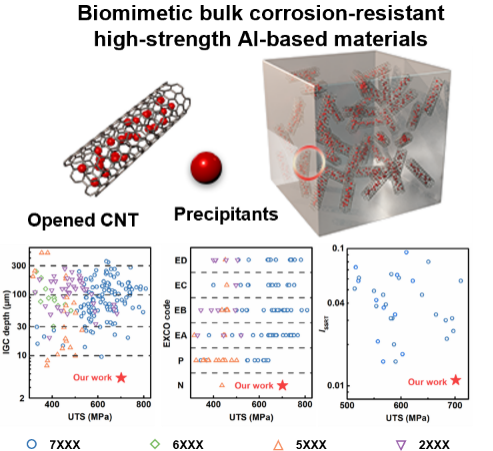High-strength aluminum (Al) alloys and their composites are essential materials for aerospace and lightweight equipment due to their unique properties. However, their poor corrosion resistance remains a significant challenge that has limited their application for decades. The design and development of Al alloys or their composites with both high strength and high corrosion resistance are currently focal points and significant challenges for researchers and industry professionals worldwide.
The research team led by Prof. ZHENG Yugui from Institute of Metal Research, Chinese Academy of Sciences (IMR, CAS) fabricated a new ultrahigh-strength 7XXX Al matrix composite with excellent corrosion resistance using a nature-inspired strategy of incorporating water-soluble precipitants into bulk metals using the inner cavity of opened carbon nanotubes (CNTs). This work was published in Advanced Materials.
The prepared corrosion-resistant high-strength Al-based metallic materials have an ultrahigh tensile strength and a life-long extraordinary corrosion resistance with extremely low susceptibility to intergranular corrosion (IGC), exfoliation corrosion (EXCO) and stress-corrosion cracking (SCC), and low corrosion rates in acidic, neutral and alkaline media. The combination of superior corrosion resistance and ultrahigh strength outperforms all previously reported Al alloys. The superior corrosion resistance is mainly due to the surface enrichment of the precipitants spontaneously released from the opened CNTs induced by the capillary action, forming a protective surface film. Using this strategy, corrosion-resistant high-strength 2024 and 6061 Al matrix composites are also successfully prepared, indicating that the strategy is scalable and has the potential to develop other high-strength, corrosion-resistant metal materials.
This study was done in collaboration with the research teams led by Prof. MA Zongyi and Prof. CHENG Hui-ming from IMR.

Superior resistance to IGC, EXCO and SCC of the high-strength 7075 Al matrix composite (Image by IMR)